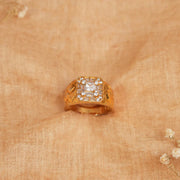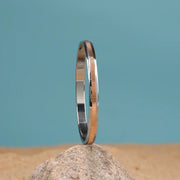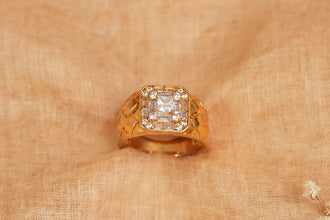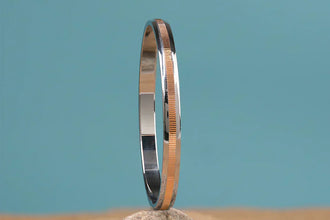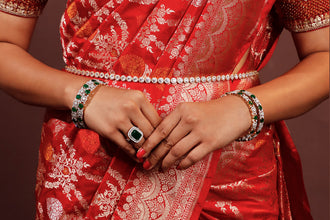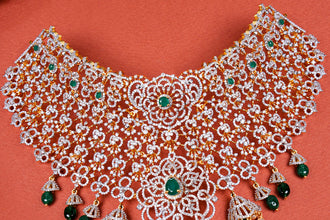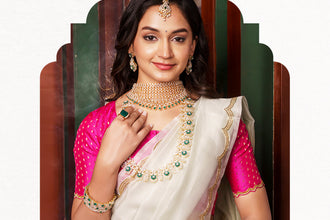Jewellery is often considered ornamental, but in India, many ornaments carry a purpose far deeper than beauty. Among them, the nose ring or nath is one of the most significant adornments worn by women. To some, it is a symbol of culture and tradition; to others, it is a fashion statement. But beyond aesthetics lies an entire world of Ayurvedic science, health benefits, and cultural symbolism that make nose piercing a meaningful choice.
The practice of nose piercing has been deeply rooted in Indian tradition, Ayurveda, and even acupressure-based healing systems. While many wear it to honour cultural values, there are scientific and health-related reasons associated with this ancient practice. At Padmam, this legacy is celebrated by blending traditional artistry with contemporary elegance, offering nose rings that reflect both heritage and modern style.
Why Do Women Wear Nose Rings in India?
The nose ring is not merely an accessory in India, but a symbol of identity, femininity, and marriage. Historically, after marriage, women in Maharashtra, Uttar Pradesh, Rajasthan, and Tamil Nadu would wear nose rings as a sign of their status. In other places, it was a mark of honour, good fortune and marital status; at other places, it represented fertility and womanhood.
However, nose rings are not only a cultural phenomenon. They have long been associated with Ayurvedic wisdom and scientific causes, which affect physical and emotional health.
The Scientific Justification of a Nose Ring
1. Ayurveda and the Left Nostril
Ayurveda suggests that the left nostril is associated with the female reproductive organs. Piercing of the left nostril is said to:
-
Regulate menstrual cycles
-
Reduce period pain
-
Ease labour pain during childbirth.
-
Support reproductive health
This is why nose piercings in India are traditionally done on the left side.
2. Acupressure Benefits
The area where the nose is pierced is also taken as an acupressure point. By stimulating this point, it may assist in:
-
Controlling hormones.
-
Lessening pains and menstrual cramps.
-
Enhancing fertility.
3. Heat Regulation in Women
Ayurveda tends to associate silver and gold jewellery with regulating body heat. A nose ring, particularly one made of silver, is thought to aid in regulating body temperature and keeping the body cool.
4. Emotional Balance and Calm
Some studies have proposed that the piercing of specific acupressure points may lead to mental calmness, emotional stability, and reduced anxiety. This may be the reason why nose piercings are also linked with emotional strength in women.
5. Increasing Confidence and Mental Health.
Along with physical advantages, jewellery can have a psychologically impactful effect. The nose ring can help a woman develop a sense of identity, boosting her self-confidence and making her feel more empowered.
Health Benefits of Nose Piercing
Wearing a nose ring is not just symbolic—it also comes with several perceived health benefits:
-
Menstrual Health – Piercing the left nostril may help alleviate menstrual pain and regulate menstrual cycles.
-
Childbirth Support – Many women believe it reduces complications during delivery.
-
Hormonal Balance – By stimulating specific nerves, it may help in maintaining reproductive health.
-
Stress Relief – Acupressure stimulation is thought to calm the nervous system.
-
Heat Management – Silver nose rings, in particular, help maintain body temperature.
While modern science does not confirm all these claims, Ayurveda and centuries of cultural practice continue to reinforce their importance.
The Cultural Significance of Nose Piercing
The nose ring is deeply ingrained in Indian culture. It is a symbol of various things according to the location:
-
Emblem of Marriage: It denotes marital status in North India, as with the mangalsutra.
-
Fertility & Prosperity: In certain societies, it is considered to be blessed with fertility and good fortune on the part of the woman.
-
Regional Identity: Maharashtrian brides wear the famous Nath, while South Indian brides wear delicately designed studs or rings.
-
Fashion Statement: Today, nose rings are embraced worldwide as a bold expression of personal style.
Thus, the nose ring continues to bridge the gap between tradition and modernity.
Ayurveda’s View on Nose Piercing
Ayurveda, India’s ancient system of medicine, links the body’s health with energy channels. According to this tradition:
-
The female reproductive system is attached to the left nostril.
-
Piercing it supports the proper flow of prana (life energy) and balances the doshas (Vata, Pitta, Kapha).
-
Nose piercing helps women align with natural cycles, reduce stress, and enhance fertility.
This makes the practice not only culturally relevant but also deeply holistic in its approach to wellness.
Modern Fashion Meets Ancient Wisdom
Nose piercing in the current world is not merely a cultural phenomenon, but also a trend. World celebrities and contemporary women wear them to represent their uniqueness and daringness.
-
The coolness of the nose ring is that it is so versatile:
-
Small silver studs for subtle elegance.
-
Delicate gold-plated rings for traditional charm.
-
Intricate naths for bridal wear.
-
Minimalist hoops for everyday style.
Thus, the modern nose ring continues to evolve—rooted in history, yet always stylish in the present.
Final Word
The nose ring is a powerful symbol that harmoniously combines culture, science, and fashion. Centuries ago, it was loved not only for its ornamental features but also for its Ayurvedic and acupressure-associated medicinal properties. From regulating feminine well-being to facilitating childbirth and ensuring a calm heart, the motivation behind nose piercing extends far beyond style.
Nowadays, it is a classic jewel, a symbol of custom, womanhood, and identity. Whether embraced as a piece of religious jewellery or a fashionable accessory, the nose ring continues to represent tradition and self-assurance. At Padmam, this timeless ornament is celebrated through designs that honour its cultural depth while adding a touch of modern elegance.
FAQ
1. Does piercing the left nostril ease childbirth?
Yes. In Ayurveda, the left nostril is associated with reproductive health, and piercing it is believed to ease labour pains and support a smooth childbirth.
2. Can nose rings reduce menstrual pain?
Traditionally, yes. Piercing stimulates acupressure points that may help reduce cramps and regulate hormonal balance, thereby easing menstrual discomfort.
3. What is the Ayurvedic reason for nose piercing?
According to Ayurveda, nose piercing helps balance the female reproductive system, regulates menstrual cycles, and supports overall wellness, making it more than just a decorative practice.
4. Is there a scientific basis for wearing nose rings culturally?
While modern medicine has limited studies on the subject, Ayurveda and traditional practices highlight physical, emotional, and reproductive health benefits, which is why the tradition continues today.


